CT Scans: Essential Tools in Brain Tumor Detection
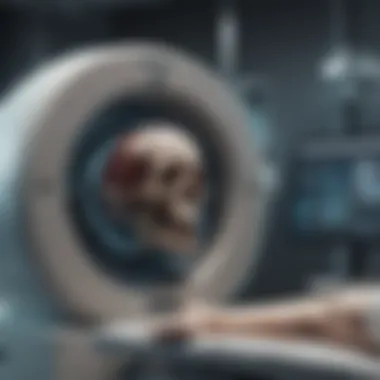
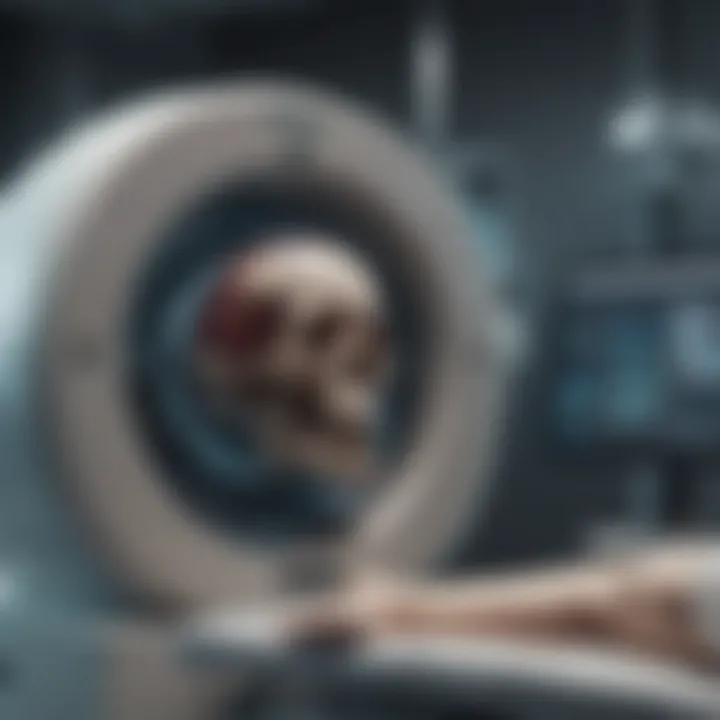
Intro
The landscape of medical imaging has evolved significantly, and CT scans have become a trustworthy ally in the world of diagnosing brain tumors. Understanding the role of these scans can illuminate paths for students and professionals in neuro-oncology. With their ability to visualize the internal workings of the brain, CT scans provide crucial insights that can lead to timely and accurate diagnoses.
Why Brain Tumor Detection Matters
Detecting brain tumors at an early stage can vastly improve a patient’s prognosis. However, the intricate nature of brain structures and the diverse types of tumors complicate this task. Here lies the importance of employing advanced imaging techniques, particularly CT scans, which can unveil well-defined images of the brain anatomy and any abnormalities.
"An accurate brain tumor diagnosis often hinges on the effectiveness of imaging techniques, where every detail counts."
In this article, we will explore various dimensions of CT scans in brain tumor detection. We will dissect its methodological framework, including the benefits and limitations associated with this technology. By unpacking this topic, we aim to foster deeper understanding for educators, researchers, and students who are delving into the intricate field of neuroimaging.
The conversation will cover more than just technical specifications; we aim to encapsulate how these images translate into clinical decisions that affect patient lives. Whether you’re looking to grasp the fundamental principles of imaging or hoping to keep abreast of future trends, this narrative promises a wealth of knowledge.
Methodology
Overview of research methods used
Here we will take an in-depth look at how research unfolds regarding CT scans and brain tumor diagnosis. Insights are gathered mainly through literature reviews of clinical studies and imaging analyses. Hospitals and academic institutions often pool their data to provide a comprehensive view of outcomes. This collaboration enriches the understanding of the efficacy of CT scans in various contexts.
Peer-reviewed studies offer a treasure trove of evidence that validates the use of CT in clinical settings.
By analyzing a mix of case studies, expert reviews, and randomized trials, researchers can unravel patterns and identify success rates associated with this imaging technique.
Data collection techniques
Data is collected through systematic approaches. For instance, patient records and imaging results serve as a primary source. Surveys and questionnaires may also be utilized to gauge clinician experiences and perceptions regarding CT efficacy. Through databases, the information can be compiled to assess accuracy, rapidity of diagnosis, and the subsequent patient outcomes.
In many cases, researchers prioritize using well-established parameters in their methodologies, providing a reliable framework for drawing valid conclusions.
Future Directions
Upcoming trends in research
As with any medical technology, advancements are on the horizon. The integration of machine learning algorithms in CT imaging is one area where significant strides are made. These innovations can potentially streamline detection processes, enabling faster diagnosis with improved accuracy.
Additionally, hybrid imaging techniques that combine PET scans with CT may offer a more comprehensive picture of brain function and tumor metabolism, which will be indispensable for tailor-fitting treatment plans to individual needs.
Areas requiring further investigation
Further exploration into patient demographics and varied tumor types can enhance understanding. The complexity of brain tumors means different approaches may need to be investigated, particularly concerning how CT scans perform across diverse populations.
A deep dive into comparative studies contrasting CT scans with other imaging methods like MRI can also prove beneficial in refining best practices in clinical settings.
Prelims to Brain Tumors
Understanding brain tumors is crucial, as they can have significant implications for health and well-being. They arise from various cells in the brain, often leading to life-altering consequences if not addressed swiftly and accurately. Symptoms can be subtle at first, which makes awareness critical for effective diagnosis and treatment. This section will set the stage for discussing the role of imaging techniques, particularly CT scans, in identifying these potentially dangerous conditions.
Defining Brain Tumors
Brain tumors refer to abnormal growths of cells within the brain. They can either originate in the brain or spread from other parts of the body, known as secondary tumors. It’s essential to delineate between these types, as their origins can determine treatment paths and prognosis. Understanding what qualifies as a brain tumor informs not only the medical community but also provides necessary insights for patients and their families.
Types of Brain Tumors
Primary vs. Secondary Brain Tumors
Primary brain tumors begin in the brain tissue itself. In contrast, secondary brain tumors originate elsewhere and spread to the brain. The distinction is not merely academic; it has direct implications on the course of treatment and the patient’s outlook. Primary tumors, while they can vary widely in their nature, would generally require different management strategies than secondary tumors, which may be symptomatic of a broader systemic issue. This fundamental aspect of brain tumors helps illustrate their complexity while emphasizing the importance of accurate diagnostics.
Common Types: Gliomas, Meningiomas, and Schwannomas
Among brain tumors, gliomas, meningiomas, and schwannomas represent some of the most frequently encountered. Gliomas arise from glial cells, which support and protect neurons. These tumors often vary in aggressiveness, demanding comprehensive treatment planning. Meningiomas, on the other hand, develop from the meninges—the protective layers surrounding the brain and spine—and are typically benign, but can still exert significant pressure on brain structures. Schwannomas originate from Schwann cells, affecting the nerves, and can lead to distinct symptoms depending on their location. This diversity in tumor types underscores the need for informed diagnostic tools, highlighting the pivotal role CT scans can play in this context.
Symptoms and Diagnosis
Common Symptoms of Brain Tumors
The symptoms presented by brain tumors can range widely. Common manifestations include persistent headaches, seizures, changes in vision, and alterations in behavior or cognitive functions. Recognizing these symptoms is vital for timely intervention. Early identification can often be a game-changer, affecting the overall treatment approach and prognosis.
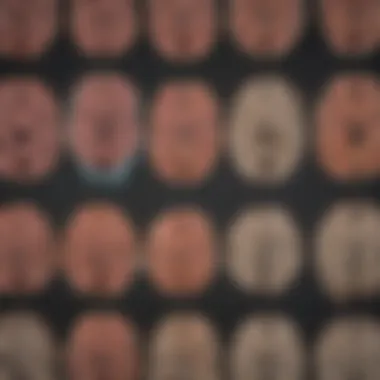

Initial Diagnostic Approaches
When a brain tumor is suspected, the journey towards diagnosis usually starts with a thorough clinical evaluation. Initial diagnostic approaches often incorporate imaging studies, including CT scans and MRIs, which help visualize abnormalities and guide further clinical decisions. The utility of these imaging techniques cannot be overstated; they often set the course for subsequent investigations and inform therapeutic choices, ensuring that patients receive appropriate care.
Accurate early diagnosis is key to effective treatment; the initial symptoms may not seem alarming, but they can conceal serious conditions.
Imaging Techniques for Brain Tumor Detection
The landscape of neuro-oncology is continually evolving, and imaging techniques have become vital to understanding and diagnosing brain tumors effectively. These modalities not only assist in identifying the presence of tumors but also help in assessing their characteristics and the surrounding tissue. In an era where swift and accurate diagnosis is of utmost importance, imaging techniques are a cornerstone of medical practice, providing clinicians with the insights necessary for developing appropriate treatment plans.
Overview of Neuroimaging
Neuroimaging encompasses a broad spectrum of techniques designed to visualize the brain's structure and function. Methods like computed tomography (CT) scans, magnetic resonance imaging (MRI), and positron emission tomography (PET) each offer unique advantages. These imaging techniques are essential for neurologists and oncologists in diagnosing brain conditions, including tumors.
Neuroimaging is paramount as it allows for:
- Detailed visualization of brain anatomy
- Identification of abnormalities such as tumors
- Monitoring of tumor development and response to treatment
In addition to pinpointing tumors, imaging studies help differentiate between various types of brain masses, which is critical since the management strategies can vary significantly based on tumor type.
Comparative Analysis of Imaging Modalities
A thorough understanding of the strengths and weaknesses of various imaging techniques is essential. CT scans and MRIs are often compared due to their prevalence in clinical settings. Each has its own set of characteristics that make them better suited for specific scenarios.
CT Scans vs. MRI Scans
CT scans are commonly used for their speed and accessibility. They utilize X-ray technology to create cross-sectional images of the brain. One major advantage of CT scans is their ability to rapidly assess severe cases, such as in emergency situations, where time is critical.
On the other hand, MRI scans provide a much clearer view of soft tissue structures within the brain. While they take longer to perform than CT scans, the resultant images are detailed and help in better understanding tumors' characteristics, such as their location and effects on surrounding tissues.
Key aspects to consider between the two:
- Speed of Acquisition: CT scans can be completed in a matter of minutes, while MRIs may take longer, affecting patient throughput in emergency settings.
- Image Resolution: MRI offers superior detail in soft tissues, crucial for diagnosing subtle brain pathology.
Both imaging techniques play indispensable roles in diagnosing and managing brain tumors. The choice between them often boils down to the clinical scenario, patient condition, and urgency of the situation.
Roles of PET and Ultrasound in Detection
While CT and MRI dominate the field of brain tumor imaging, other modalities like PET and ultrasound also have their places in diagnosis and monitoring. PET scans involve the use of radioactive substances to observe metabolic activity, providing insights into how active a tumor may be. This information is particularly useful in distinguishing aggressive tumors from less active ones.
Ultrasound, although not typically used for brain imaging in adults, can provide guidance in pediatric cases or for monitoring certain conditions due to its safety profile. Its reliance on sound waves makes it a non-invasive option, albeit with limitations in imaging depth compared to CT and MRI.
Understanding CT Scans
In the realm of medical imaging, understanding CT scans is crucial for both practitioners and students alike. These scans serve as a fundamental aspect of diagnosing brain tumors, providing insights about their size, shape, and location within the cranium. When it comes to neuroimaging, CT scans hold a unique position due to their rapid execution and widespread availability, making them an invaluable tool in emergency settings and routine assessments.
A CT scan, or computed tomography scan, employs a series of X-ray views taken from different angles around the body. The data is then processed using advanced computer algorithms to create cross-sectional images. This technique not only facilitates visualization of internal structures but also enhances diagnostic capabilities in conditions often hidden from plain sight. Ultimately, a solid grasp of how CT scans work is integral to appreciating their role in the landscape of brain tumor detection.
Mechanism of CT Imaging
At its core, CT imaging combines multiple X-ray images taken from various angles with the help of a rotating X-ray tube. Once these images are captured, they are reconstructed using computer algorithms to form detailed cross-sectional images or 'slices' of the brain. This method allows radiologists to assess brain tumors more precisely.
The interplay of various factors, such as the density of tissues, can significantly influence the clarity of the images. Tissues that are denser, like tumors, often appear brighter in a CT image, aiding in their identification. The speed at which CT scans can be performed is another major advantage; they typically take just a few minutes. Despite this efficiency, understanding the intricacies of how these images are generated can enhance a practitioner's interpretative skills, leading to more accurate diagnoses.
Types of CT Scans Applied in Neuroimaging
Within the domain of CT imaging, two primary types are employed in neuroimaging: standard non-contrast CT scans and contrast-enhanced CT scans.
Standard Non-Contrast CT Scans
Standard non-contrast CT scans offer a fundamental approach to imaging the brain. This type of scan is often the first line of investigation, especially in emergency situations where brain edema or hemorrhage is of concern. The key characteristic of this approach is its speed and ability to produce immediate images without the need for contrast agents.
The benefits of using standard non-contrast CT include:
- Quick execution: Critical in emergency settings, providing immediate information for treatment decisions.
- Accessibility: Widely available in most hospitals and clinics.
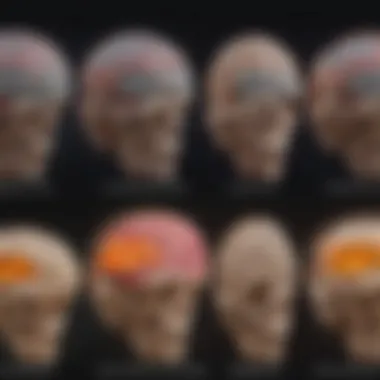
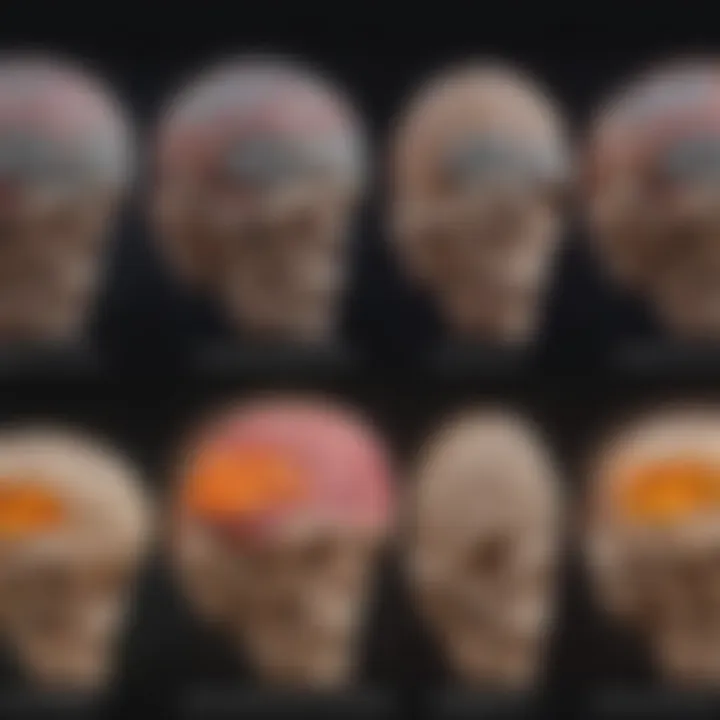
However, the trade-off comes in the detail. While these scans can be effective in spotting larger tumors or acute conditions, subtler abnormalities can sometimes slip through the cracks. Therefore, they often serve as an initial step before more detailed imaging techniques are employed.
Contrast-Enhanced CT for Tumor Visualization
Contrast-enhanced CT scans further facilitate brain tumor visualization by utilizing a contrast agent, typically iodine-based, which is injected into the patient's bloodstream before the imaging process. This method heightens the visibility of abnormalities, often illuminating the borders and internal structure of tumors.
The unique feature of contrast-enhanced CT scans lies in their ability to delineate tumor characteristics. They add significant value by:
- Improving contrast visibility: Allowing distinct differentiation between tumor tissues and surrounding healthy brain matter.
- Assessing blood supply to tumors: Providing insights into tumor vascularity and growth.
Despite these advantages, contrast-enhanced CT scans do carry certain risks, including potential allergic reactions to the contrast material and considerations related to radiation exposure. Knowing when and how to use these scans is crucial in optimizing patient outcomes in the complex field of neuro-oncology.
Can CT Detect a Brain Tumor?
Computed tomography, or CT scans, are a vital tool in the early detection and evaluation of brain tumors. Understanding their capabilities and limitations is crucial for anyone involved in the field of neuro-oncology. The significance of CT scans lies not just in their ability to visualize potential tumors but also in their role as a first-line diagnostic method that can guide further investigation.
A CT scan provides detailed images of the brain, aiding in the identification of abnormalities that could suggest the presence of a tumor. For instance, in emergency cases, rapid results are invaluable for decision-making regarding subsequent treatment pathways. Yet, while CT scans hold their own, a nuanced examination of their sensitivity and specificity is essential to fully grasp their utility in clinical practice.
Sensitivity and Specificity of CT Scans
When it comes to diagnosing brain tumors, two critical metrics to consider are sensitivity and specificity. Sensitivity refers to the ability of the CT scan to correctly identify those who have the disease, while specificity indicates the test's ability to correctly identify those without the disease.
CT scans rank fairly well in terms of sensitivity when it comes to detecting larger tumors, especially those that disrupt normal brain tissue or create swelling. However, it's important to acknowledge that smaller or subtler tumors might elude detection. This is particularly the case for tumors that are nestled near critical brain structures, where imaging might not reveal them due to overlapping tissues.
In terms of specificity, CT scans can sometimes produce false positives. That is, areas of the brain that may appear abnormal due to infections or other non-tumor related conditions can mislead the diagnosis. This emphasizes the need for thorough follow-up procedures and additional imaging modalities such as MRI scans to confirm any findings observed on a CT scan.
Assessment of Visibility of Tumors
Determining the visibility of tumors on CT scans encompasses several factors, including size and location, as well as the contrast between the tumor and the surrounding tissue. Each aspect plays an integral role in establishing whether a tumor can be convincingly identified through CT imaging.
Size and Location Factors
The size of a tumor is a salient factor in its visibility on a CT scan. Larger tumors, generally greater than a few centimeters, often present a much clearer picture, allowing for accurate observations. Their proliferation may lead to exposure of the surrounding brain tissue, offering diagnostic clues.
However, location also matters significantly. Tumors situated in regions where they can displace normal brain tissue tend to be easier to spot. In contrast, tumors located deeper within the brain or tucked away in areas less susceptible to distortion may remain hidden from even the most adept imaging techniques. This juxtaposition elucidates why size and location are commonly discussed characteristics in the context of CT effectiveness.
Contrast between Tumor and Surrounding Tissue
The contrast between the tumor and the surrounding tissue is another pivotal aspect of tumor visibility in CT imaging. A higher contrast ratio typically translates to superior identification capabilities. When a tumor has different density characteristics compared to the adjacent brain tissue, it is more likely to stand out on a CT scan.
For instance, tumors that are calcified or that contain differing cellular structures can appear quite distinctly against the surrounding normal brain tissue. However, achieving appropriate contrast often relies on specific patient factors, such as the tumor’s inherent characteristics and the method of contrast used during the scan, if applicable.
Advantages of Using CT Scans
CT scans offer distinct advantages in the realm of brain tumor detection that can significantly impact patient outcomes. One crucial factor in evaluating the effectiveness of any diagnostic tool is its ability to deliver timely and accurate results. Understanding the strengths of CT scans is pivotal for healthcare providers, as it facilitates well-informed decision-making in the clinical setting.
Speed and Accessibility
In today's fast-paced medical environment, speed is of the essence, especially when dealing with potential brain tumors. CT scans are like an express train compared to other imaging modalities. They can be performed swiftly, often within a matter of minutes, allowing for immediate visualization of the brain structure. For instance, in a hospital setting, a patient presenting with sudden severe headaches or neurological symptoms can undergo a CT scan quickly, often reducing the wait time that can occur with MRI scans. This rapid response is life-saving in cases where a brain tumor could lead to increased intracranial pressure or hemorrhage.
The accessibility of CT scans is another notable advantage. They are widely available in most healthcare facilities, from large hospitals to smaller clinics. This widespread availability means that patients in rural areas or underserved communities can access these imaging services without having to travel long distances. Furthermore, the cost-effectiveness of CT imaging plays a significant role in healthcare decisions. Many insurance plans cover CT scans, making them appealing for both patients and healthcare systems.
Effective for Emergency Situations
CT scans truly shine in emergency conditions. When time is critical, the ability to rapidly diagnose a brain tumor can dictate treatment options and ultimately, a patient's prognosis. Conditions such as seizures, acute headaches that differ from usual patterns, or any unexplained changes in mental status require urgent evaluation. A CT scan allows physicians to identify potential tumors, bleeding, or other abnormalities almost immediately.
Patients suspected of having brain tumors often face a race against time. For example, if a patient arrives in the emergency room with an acute stroke, deciding whether the symptoms stem from a brain tumor or an ischemic event is vital. The clarity provided by a CT scan is invaluable in these moments. The imaging results can steer the medical team towards the correct course of action, allowing for timely intervention.
Furthermore, a CT scan can serve as a preliminary assessment tool, enabling healthcare professionals to determine the necessity for further imaging or surgical intervention. In some instances, the speed of CT results can lead to immediate life-saving treatments, which might include surgery or theraeputics to alleviate pressure on the brain.
"Time is brain. Every minute counts when it comes to neurological evaluations, and CT scans help bridge that crucial gap."
Limitations and Challenges


When discussing the role of CT scans in detecting brain tumors, it's crucial to address the limitations and challenges that accompany their use. While CT technology has advanced considerably, understanding its shortcomings is vital for healthcare professionals, patients, and anyone involved in neuroimaging. The crucial elements include radiation exposure, potential missed diagnoses, and other considerations that can affect outcomes and overall patient care.
Radiation Exposure Concerns
One major drawback of CT scans is the associated radiation exposure. Unlike other imaging modalities, such as MRI, which do not involve ionizing radiation, CT scans utilize X-rays to produce detailed images of the brain. While the benefits of accurate tumor localization can outweigh risks, there is an ongoing debate about how much radiation is deemed acceptable. Healthcare professionals must weigh the advantages of immediate imaging against the long-term effects of radiation, especially in pediatric cases where sensitivity to radiation is higher.
Quote: "Radiation dose during a CT scan may significantly increase the risk of developing cancer later in life, particularly among younger patients."
This concern leads to careful consideration of when a CT scan is absolutely necessary. In life-threatening emergencies, the speed of diagnosis can be vital, but in other cases, alternative imaging methods might be preferable due to lower risks.
Potential Overlooked Tumors
CT scans, despite being effective, can inadvertently miss certain types of tumors. The detection challenges can arise from multiple factors involved in the imaging process.
Microscopic Tumors
Microscopic tumors are often notoriously difficult to detect through CT imaging. Their small size can render them obscure on scans, leading to negative results even when a tumor is present. These tumors may not cause immediate or severe symptoms, which can result in a lack of routine screening until significant issues arise. This is particularly concerning in cases where a patient may exhibit vague neurological symptoms that do not prompt further investigation through alternative imaging techniques. The lack of visibility for these tiny tumors could lead to delayed diagnosis, complicating treatment options later on. The key characteristic of microscopic tumors is their size; indeed, it presents a significant challenge in early detection. This aspect is essential in shining light on why relying solely on CT scans can be inadequate, as a missed microscopic tumor can lead to considerable complications down the line.
High-Grade Tumors with Subtle Presentation
High-grade tumors, although typically more aggressive and easily identifiable, can also present subtle features that complicate detection. Sometimes these tumors may not cause clear or acute symptoms, leading clinicians to underestimate their presence based on a CT scan.
These tumors often have a variability in their appearance—some may blend into surrounding tissues, which makes them less conspicuous during imaging. This problem can result in a false sense of security, where clinicians may inaccurately conclude that a tumor is absent or of lesser concern than it actually is. The unique aspect of high-grade tumors lies in their aggressive nature; they require prompt treatment, but if they are mischaracterized on a CT scan, the consequences can be dire.
When outlining the limitations in CT technology, it's important to keep these insights at the forefront. Balancing the effectiveness of imaging with the reality of its constraints is essential in fostering effective interventions and ensuring patients receive appropriate care.
Future Directions in Neuroimaging
The realm of neuroimaging is ever-evolving, particularly in how we detect and understand brain tumors. The strides made in this field are not just about technological advancement; they also hold the promise of significantly enhancing diagnosis and treatment outcomes. Future directions in neuroimaging will likely focus on refining current methods, mitigating limitations, and integrating various modalities to present a more complete picture of brain health.
Innovations in CT Technology
Innovations in CT technology are crucial. One of the most notable advancements is the enhancement of image resolution. High-definition imaging capabilities allow for better visualization of tumors in smaller and more complex regions of the brain. Additionally, iterative reconstruction techniques are increasingly implemented to reduce noise and improve image clarity without increasing radiation doses. These improvements are paving the way for CT scans to be more potent and reliable than before.
- Dynamic Imaging: New algorithms are in the works that will enable real-time imaging, which can capture tumor dynamics during treatment and provide immediate feedback to healthcare professionals.
- Dose Optimization: Ongoing research aims to minimize radiation exposure while maintaining diagnostic quality. This is particularly important in younger patients who may need repeated scans.
Integration of Imaging Techniques
Integrating multiple imaging modalities, such as CT with MRI and PET, represents a significant leap forward. By combining these techniques, clinicians can gain comprehensive insights that single modalities may miss.
Combining CT with MRI and PET
Combining CT with MRI and PET creates a powerful diagnostic toolkit. The key characteristic of this approach lies in its ability to provide anatomical detail from the CT while offering metabolic and functional information from the PET and MRI scans. This synergistic relationship enhances tumor detection and characterizes tumor types more accurately.
- Advantages: This combination enables early detection of tumors that might be obscure on a standalone CT scan, ensures precise localization, and assists in differentiating tumor types.
- Challenges: Although the benefits are clear, the drawbacks include increased complexity in imaging and interpretation, requiring clinicians to be well-versed in multiple imaging modalities.
Artificial Intelligence in Imaging Analysis
Incorporating artificial intelligence into imaging analysis is a game changer. This key characteristic of leveraging AI lies in its ability to process vast amounts of data rapidly, aiding radiologists in identifying anomalies with greater accuracy. AI can identify patterns in imaging datasets that might escape human observers.
- Unique Features: AI algorithms can be trained to recognize specific tumor characteristics, significantly speeding up the process of diagnosis. They can also potentially predict tumor behavior based on historical data and imaging results.
- Pros and Cons: While AI brings efficiency and potentially improved outcomes, challenges exist, including the need for large training datasets and the importance of human oversight to validate AI-driven conclusions.
Finale
In the realm of neuro-oncology, the spotlight on CT scans illuminates their vital role in the early detection and assessment of brain tumors. While advancements in imaging technologies continue to shape the field of medical diagnostics, the contributions of CT scans can't be brushed aside. They serve as critical tools that not only assist in identifying tumors but also provide invaluable information about their characteristics—like size and location—which can guide treatment decisions.
One of the key elements to emphasize here is the speed at which CT scans can be conducted. In emergency scenarios, where immediate information is paramount, their ability to produce results swiftly can be a game changer. No healthcare professional wants to dither when milliseconds can make a difference in patient outcomes.
However, it’s equally important to approach the topic with a critical lens. As elucidated throughout this article, while CT scans offer quick results and accessibility, they do have limitations, particularly concerning radiation exposure and their sensitivity to subtle tumors. This duality necessitates a thoughtful consideration about when and how to use this imaging technique effectively.
In summary, understanding the role of CT scans in detecting brain tumors is not merely academic; it has real-world implications for patient care. By weighing the advantages against the challenges, medical professionals can better navigate the complex landscape of brain tumor diagnostics.
Key Takeaways
- Speed and Accessibility: CT scans provide rapid diagnostics, especially useful in emergency settings.
- Comprehensive Information: They help determine tumor characteristics that are critical for treatment evaluation.
- Limitations: Awareness of the constraints such as radiation exposure and potential for missed diagnoses is essential.
- Integration with Other Modalities: Combining CT scans with MRI or PET can enhance diagnostic accuracy.
Future Implications for Research and Practice
Looking ahead, the future of neuroimaging in brain tumor detection is poised for transformation. One promising area is the innovation in CT technology. For instance, advancements such as iterative reconstruction techniques aim to improve image quality while reducing radiation dose, addressing a long-standing concern in radiology.
Additionally, integrating imaging techniques can potentially bridge the gap between the strengths of various modalities. As highlighted previously, the combination of CT with MRI and PET could create a more comprehensive picture of brain tumors, enhancing diagnostic capabilities. Furthermore, the infusion of artificial intelligence into the imaging analysis process holds promise for elevating diagnostic accuracy, potentially flagging atypical presentations that might be overlooked by the human eye.







